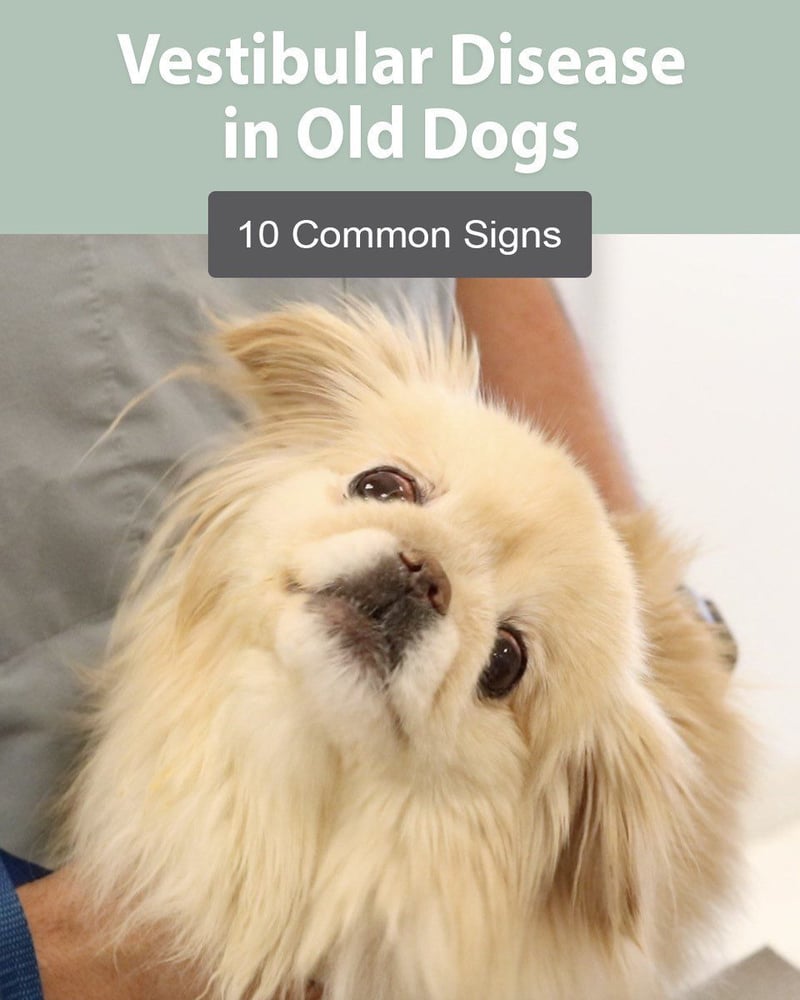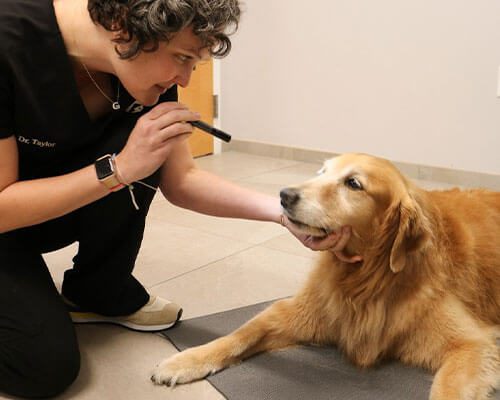10 Common Signs of Vestibular Disease in Old Dogs
Senior dogs can have vestibular dysfunction for all the same reasons younger dogs do. However, vestibular disease in old dogs is often due to canine idiopathic vestibular syndrome, which is why it is commonly known as old dog vestibular disease.

What Is Vestibular Disease in Old Dogs?
The vestibular system is responsible for balance, coordination, and orientation in animals. It is made up of the peripheral vestibular system, including the inner ear and nerves traveling from the ear to the brain, and the central vestibular system, consisting of the brainstem and the cerebellum.
Any disturbance to this balance system is referred to as vestibular disease. Causes of vestibular disease are separated into problems affecting the peripheral vestibular system and problems affecting the central vestibular system. Problems affecting the central vestibular system are typically much more serious.
Fortunately, vestibular disease in old dogs is often diagnosed as idiopathic. Idiopathic vestibular disease is a sudden and nonprogressive disturbance to the peripheral vestibular system. Idiopathic means there is no known cause. Though symptoms are quite severe, they usually improve over the next few weeks without any specific treatment.
What Are Signs of Vestibular Disease in Old Dogs?
The most apparent symptom of any form of vestibular disease is a loss of balance, or more specifically, vestibular ataxia. This manifests as your dog walking like a drunken sailor, leaning and falling to one side. It can be so severe that a dog just rolls over, over and over again.
Signs of old dog vestibular disease may include:
- Sudden loss of balance
- Leaning, falling, or rolling to one side
- Head tilt to one side
- Nausea and vomiting
- Abnormal eye movements
- Abnormal eye positions
- Normal level of consciousness
- Normal postural reactions
- Nonprogressive
- Signs begin to improve within 72 hours
Of these signs, what differentiates old dog vestibular disease from other forms is that symptoms are the worst during the first 48 hours, noticeably improve within 72 hours, and mostly resolve over two to three weeks. While most dogs significantly improve, a head tilt may remain after recovery. Rarely, there may be a subsequent episode in the same dog.
How Is Vestibular Disease in Old Dogs Treated?
Vestibular disease is treated by addressing the underlying cause, whatever that may be. If your dog’s vestibular disease is diagnosed as idiopathic, or old dog vestibular disease, treatment will consist of supportive care until the condition resolves.

You can help your dog recover from old dog vestibular disease by:
- Confining your dog to a safe, quiet, and comfortable resting place
- Surrounding your dog with a thick rolled up blanket for support
- Keeping the floor clear of obstacles and blocking off stairs and pools
- Keeping food and water close by
- Assisting with eating and drinking if necessary*
- Administering anti-nausea medication if necessary
- Changing your dog’s position to prevent bedsores if necessary
- Not carrying your dog, as they need to retrain their navigation system
- Using a body harness with a handle to help hold your dog up
*It is important that animals be fed with their front end upright. Feeding them on their side can lead to accidentally inhaling food and developing aspiration pneumonia.
Is It Safe to Assume Vestibular Disease in Old Dogs Is Idiopathic?
It is not safe to assume vestibular disease in old dogs is idiopathic. On the contrary, it’s always important to have your dog examined by a veterinary neurologist because idiopathic, or old dog vestibular disease, is a diagnosis by exclusion that can only be achieved after other more serious causes have been ruled out.
There are many possible causes of vestibular disease in old dogs, and conditions that affect the central vestibular system are much more serious and difficult to treat. Without knowing the underlying cause, your dog might not receive the appropriate course of treatment.
Generally, there are three steps necessary for determining the cause of vestibular disease:
- A thorough history, a physical, and a neurological exam, which can help determine if your dog’s problem is in the peripheral or central vestibular system
- Blood tests and X-rays to screen for general health, underlying causes, and cancer or infection in the lungs, which also helps determine if your dog is healthy enough to undergo anesthesia
- Magnetic resonance imaging (MRI) and cerebrospinal fluid (CSF) analysis to rule out any other possibilities and definitively determine the cause of your dog’s vestibular disease
Southeast Veterinary Neurology Is South Florida’s Most Trusted Name When It Comes to Vestibular Disease in Dogs
Dr. Amanda Taylor, Veterinary Neurologist at Southeast Veterinary Neurology, adds, “Vestibular disease in old dogs can be stressful for the patient and scary for their family to see happen. We are always quick to address these patients in diagnostics or treatment so that we may get them comfortable as soon as possible. Fortunately, with idiopathic vestibular disease, most cases have a good outcome after thoughtful care at home over a few days.”

Southeast Veterinary Neurology offers treatment options for every vestibular patient. Contact us around the clock by calling any one of our locations in Miami, Boynton Beach, Jupiter, and Virginia Beach if you notice any signs of vestibular disease in your dog.